Introduction – Solar Irradiance Measurements
Solar Irradiance Measurements: “Since 2003, scientists have had a powerful tool to help them observe variations in the Sun’s energy output. NASA’s Solar Radiation and Climate Experiment (SORCE) has been making precise measurements of the Sun’s total and spectral irradiance, which are being combined with prior measurements to provide new insights in the long term solar variations. Onboard SORCE, the Total Irradiance Monitor (TIM) measures the total solar irradiance (TSI).
Because solar activity influences the Sun’s output differently at every wavelength, SORCE also includes three other instruments, which measure the Sun’s energy at individual wavelengths: XUV Photometer System (XPS) for soft-X-ray irradiance; Solar Stellar Irradiance Comparison Experiment (SOLSTICE) for solar ultraviolet irradiance; and Spectral Irradiance Monitor (SIM) for visible/near infrared irradiance.
This unique and unprecedented combination of instruments monitors simultaneously both the total solar energy reaching our planet (the single most important contributor to natural climate variability) and how the Sun’s energy output changes at different wavelengths. These latter measurements are used to determine the atmosphere’s response to the Sun’s changes. Changes occurring in the ultraviolet portion of the spectrum alter the amount of ozone in the atmosphere, which can impact large-scale atmospheric motions that couple the stratosphere and troposphere. Changes occurring at longer wavelengths, in the visible and near-infrared part of the spectrum, impact climate more directly by changing the heating at the Earth’s land and ocean surface, and lower atmosphere” (Tom Woods, Laboratory for Atmospheric and Space Physics, University of an Judith Lean, Naval Research Laboratory, Washington, DC, full text – The Sun Approaches Its 11 Year Minimum and Activity Cycle 24.
Spectral Irradiance Monitor(SIM)
The Spectral Irradiance Monitor is a newly designed spectrometer that provides the first long-duration solar irradiance measurements in the visible and near infrared (Vis/NIR). The wavelength coverage is primarily from 300 to 2400 (nanometres) nm, with an additional channel to cover the 200-300 nm ultraviolet spectral region to overlap with the SOLSTICE, another instrument on-board the SORCE satellite.
Understanding the wavelength-dependent variability throughout SIM’s wavelength range is of primary importance for long-term climate change studies on Earth. SIM is a single optical element Fèry prism spectrometer; only one optical element is needed to focus and disperse the light onto a series of detectors in the spectrometer’s focal plane. In this focal plane, four photodiode detectors and an electrical substitution radiometer (ESR) are used to detect and conduct solar irradiance measurements. SIM contains two completely independent and identical (mirror-image) spectrometers to provide redundancy (back-up) and self-calibration capability.
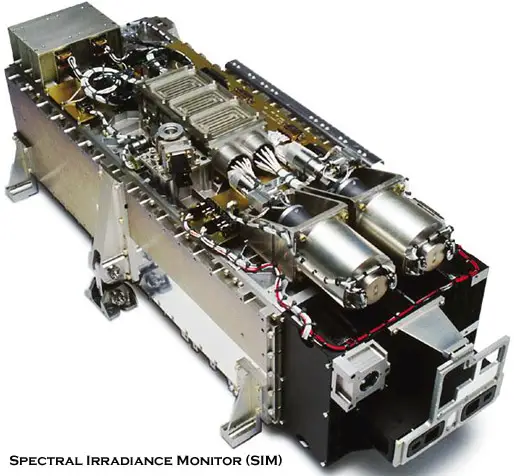
Solar Stellar Irradiance Comparison Experiment (SOLSTICE)
The SOlar Stellar Irradiance Comparison Experiment (SOLSTICE) is one of four solar irradiance measurements, launched as part of an experiment in the Solar Radiation and Climate Experiment (SORCE) on January 25, 2003. SORCE SOLSTICE is a follow-on to the very successful SOLSTICE launched aboard the Upper Atmospheric Research Satellite (UARS) in 1991. The new SOLSTICE makes daily ultraviolet (115-320 nm)solar irradiance measurements and compares them to the irradiance from an ensemble of 18 stable early-type stars. This approach provides an accurate monitor of instrument in-flight performance and provides a basis for solar-stellar irradiance comparison for future generations.
The SOLSTICE measurements are made using a pair of identical spectrometers. Each spectrometer is independently housed and mounted on the spacecraft optical bench and can operate in either of two modes. These instruments utilize traditional techniques of scanning spectrometers to make ultraviolet spectral measurements in two intervals: 115-180 nm and 170-320 nm. Two instruments are required to simultaneously measure the two intervals, but each of the two SOLSTICE spectrometers is capable of measuring either interval. During normal operations, one of the spectrometers operates in the short-wavelength mode and the other operates in the long-wavelength mode. In the event of either a full or partial instrument failure, one instrument can serve the dual role of observing both spectral intervals but at a lower frequency.
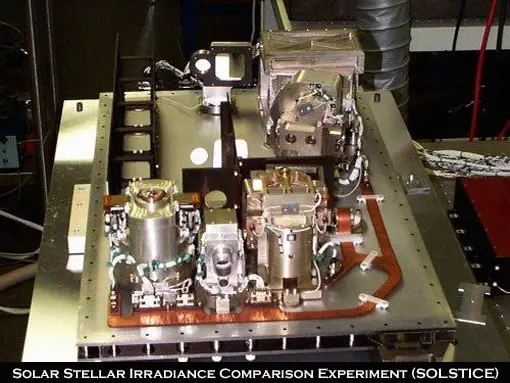
Total Irradiance Monitor(TIM)
The TIM measures the total solar irradiance (TSI), the integrated solar radiation incident at the top of the Earth’s atmosphere. The TIM continues this climate record, which began in 1978 and is used to determine the sensitivity of the Earth’s climate to the natural effects of solar forcing.
The TIM TSI measurements monitor changes in incident sunlight to the Earth’s atmosphere via an ambient temperature active cavity radiometer. Using state-of-the-art technologies in its Electrical Substitution Radiometers (ESRs) and taking full advantage of new materials and modern electronics, the TIM measures TSI to an estimated absolute accuracy of 350 ppm (0.035%). Relative changes in solar irradiance are measured to less than 10 ppm/yr (0.001%/yr), allowing determination of possible long-term variations in the Sun’s output.
Precise solar irradiance measurements obtained during the past 3 decades imply that the TSI varies on the order of 0.1% over the 11-year solar cycle, but with greater variations on day-to-month scales due to solar rotation and the passage of sunspots and facular regions across the solar disk. Variations in TSI occur over time scales from minutes to 11-year solar cycles and longer. Climate models including sensitivity to solar forcing estimate a global climate change of up to 0.2° C due to solar variations over the last 150 years.
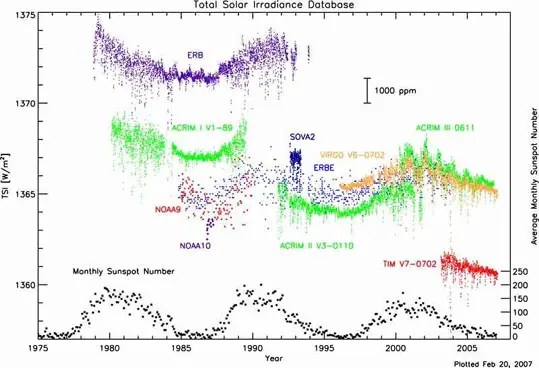
To determine long-term changes in the Sun’s output, which may have time scales extending much longer than the 11-year solar cycle, the TSI climate record requires either very good absolute accuracy or very good instrument stability and continuous measurements. To date, no TSI instrument has achieved the necessary absolute accuracy, and the TSI record relies on measurement continuity from overlapping spacecraft instruments (see TSI Database Figure above).
The SORCE/TIM instrument continues the 3-decade long climate record of spaceborne TSI measurements. The TIM has an estimated absolute accuracy of 350 ppm, where 1 ppm = 0.0001%, and a long-term repeatability for detecting relative changes in solar irradiance of 10 ppm per year.
In addition to the TIM instrument on the SORCE spacecraft, there are two other assembled TIM instrument ground witness units. One is maintained in a LASP cleanroom, and the other is intended for intercomparisons to other calibration facilities or instruments. Ground witnesses of the critical components used in the TIM are maintained, including spare flight apertures, voltage references, and absorptive cavities.
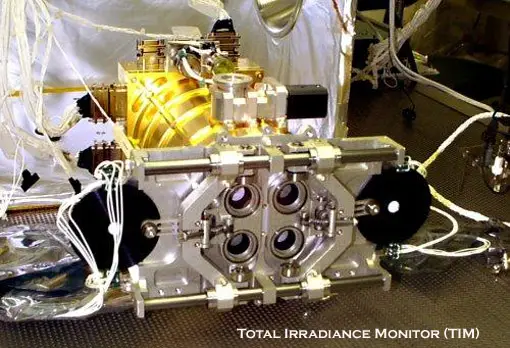
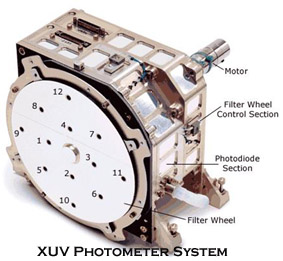 XUV Photometer System
XUV Photometer System
Studies of the solar XUV radiation began in the 1960s with space-based rocket experiments, but the knowledge of the solar XUV irradiance, both in absolute magnitude and variability, has been questionable due largely to the very limited number of observations.
With the launch of Solar & Heliospheric Observatory (SOHO) in 1995, Student Nitric Oxide Explorer (SNOE) in 1998, and Thermosphere-Ionosphere-Mesosphere-Energetics-Dynamics (TIMED) spacecraft in 2001, there is now a continuous data set of the solar XUV irradiance, and advances in the understanding of the solar XUV irradiance have begun. The SORCE XPS, which evolved from earlier versions flown on SNOE and TIMED, continue on these solar irradiance measurements with improvements to accuracy, spectral image, and temporal change.
The XPS measures the solar soft x-ray (XUV) irradiance from 1 to 34 nm and the bright hydrogen emission at 121.6 (H I Lyman-alpha). The solar XUV radiation is mostly emitted from the hot, highly-variable corona of the Sun, and these high-energy photons are a primary energy source for heating and ionizing Earth’s upper atmosphere. Of all the SORCE instruments, the XPS is most sensitive to flare events on the Sun as the solar XUV radiation often changes by a factor of 2 to 10, or more, during flares. The 12 XUV Photometers (XPs) are grouped into 3 sets. Each set of 4 XPs is arranged in a circle for use with the filter wheel mechanism. The filter wheel, which has 3 different rings of filters for the 3 sets of XPs, has 8 positions: 4 blocked for dark measurements, 2 clear for solar XUV measurements, and 2 with fused silica windows for solar visible background measurements.
An observation run is a sequence of measurements from 5 consecutive filter wheel positions, normally starting and ending with dark measurements. XP #1-4 are grouped in the inner ring. XP #5-8 are grouped in the middle ring. XP #9-12 are grouped in the outer ring. XP #1, 5, and 10 are redundant XPs as part of the in-flight calibration plan. XP #4, 8, and 12 are bare photodiodes for measuring the fused silica window transmission during each observation run.
From this page you can see how satellite based solar irradiance measurements have become very sophisticated and technical.
